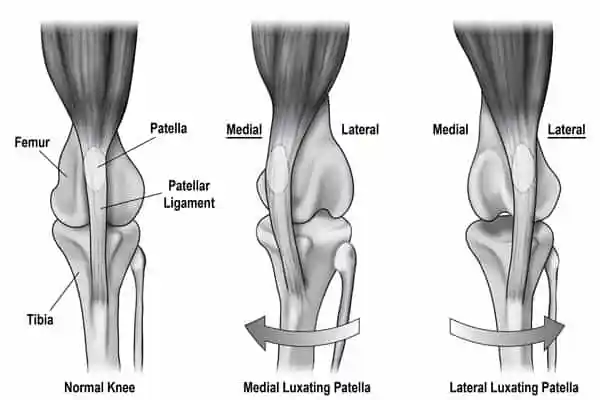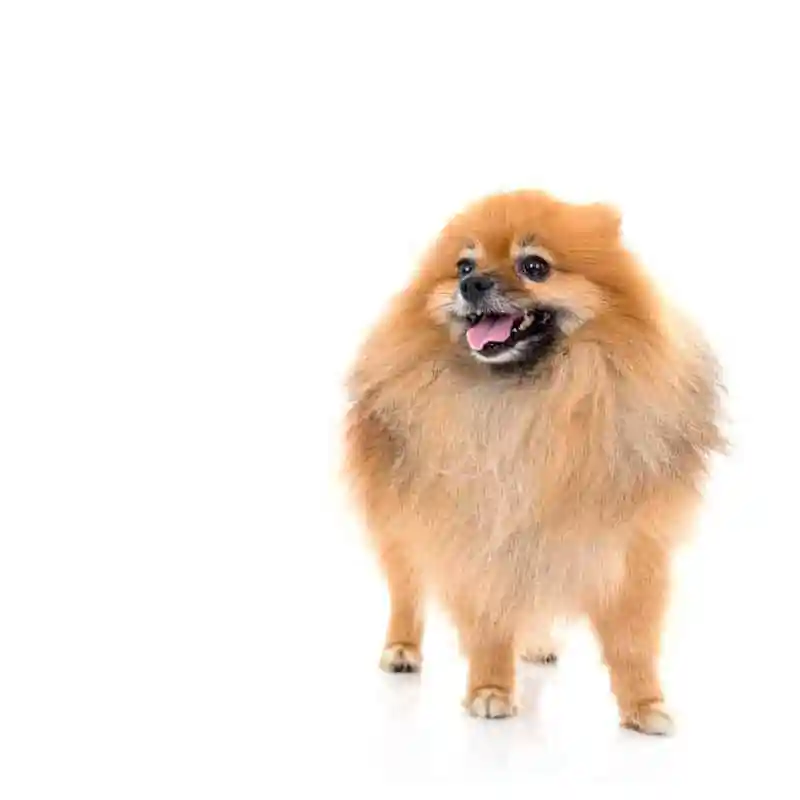A luxating patella occurs when the knee cap moves out of its natural position. The patella (knee cap) lies in a cartilaginous groove at the end of the femur at the stifle. The patella in dogs is shaped like an almond and its purpose is to assist in knee extension. The patella resides in the tendon of the quadriceps muscle group which attaches to the bone below the femur, the tibia. When this muscle group contracts, it pulls on the tendon and the knee cap, thereby extending the stifle. If the patella is pulled out of its normal groove with knee extension, this is called a luxating patella.
The causes of this condition can be congenital, genetic and/or traumatic. Breeds with a predisposition for luxating patellae are Miniature and Toy Poodles, Maltese, Jack Russell Terriers, Yorkshire Terriers, Pomeranians, Pekingese, Chihuahuas, Cavalier King Charles Spaniels, Papillons and Boston Terriers. Large breed dogs prone to this condition include Labrador Retrievers, Golden Retrievers, Akitas, Malamutes, Boxers, Huskies and St. Bernards. Apart from breed predilection, if a dog has poor conformation, such as no angulation in the hock, then this can also cause luxating patellae.
Occasionally, a luxating patella can lead to a ruptured cranial cruciate ligament. The literature states that at least 15% to 20% of dogs with patellar luxation will eventually rupture their cranial cruciate ligament.

Darryl L. Millis, MS, DVM, DACVS, DACVSMR, CCRP
Professor of Orthopedic Surgery & Director of Surgical Service
Robin Downing, DVM, MS, DAAPM, DACVSMR, CVPP, CCRP
Diplomate of the American Academy of Pain Management, is a a founder and past-president of the International Veterinary Academy of Pain Management.
Janet B. Van Dyke, DVM
Diplomate American College of Veterinary Sports Medicine and Rehabilitation, CCRT, CEO
Ludovica Dragone, DVM, CCRP
Vice President of VEPRA, Veterinary European of Physical Therapy and Rehabilitation Association.
Andrea L. Henderson, DVM, CCRT, CCRP
Resident, Canine Sports Medicine and Rehabilitation
Steven M.Fox, MS, DVM, MBA, PhD
President Securos. Inc

“ Who can resist those sweet puppy eyes and kisses? It is rare for someone to not melt or swoon over a darling furball of energy. But it is rare that someone pauses to ponder over the origin of that puppy. It is not rare that most people are unaware and would be surprised to learn that there is a huge commercial industry dedicated to mass production of these animals. “
A dislocated kneecap is usually caused by a genetic malformation or trauma. The clinical signs of the condition will normally start showing approximately four months after birth.
A genetic predisposition to luxating patellas occurs in a variety of small and tiny dogs, including:
Short-legged dogs, for example Basset Hounds and Doxies, aren’t genetically prone to the condition. However, because their femurs are so short, it can change the angle of the seating of the kneecap, and these dogs can end up with luxating patellas as well.
Larger breeds have less genetic predisposition to problems with the kneecap. They typically have a nice, deep groove for the patella to seat in.
However, larger dogs are prone to hip problems. If a joint above the kneecap like the hip joint, or one below the kneecap like the ankle develops a problem, it can change the ergonomics of the animal’s body. If there’s a problem with your dog’s hip, it can cause a kind of ripple effect that forces the patella out of its groove.
Large and giant breed dogs with hip dysplasia often have a secondary condition of luxating patella which is caused by the malformation of the hip joint.
Patellar luxation causes intermittent and chronic hind limb weakness, lameness and pain. The clinical signs of this condition can vary from dog to dog depending upon their pain tolerance and the severity of the displacement, but the symptoms typically include one or more of the following:
The signs seen by owners will vary depending on the severity of the patellar displacement, the amount of degenerative osteoarthritis involved, the particular dog’s pain tolerance level and the existence and extent of any other stifle abnormalities, such as cranial cruciate ligament rupture or tear. Some dogs develop an unusual “skipping” gait that waxes and wanes depending on the degree of pain they are experiencing.

While many competent veterinarians routinely perform a complete blood count, a serum biochemistry profile and a urinalysis on dogs displaying lameness or other obvious signs of pain, the results of these tests are typically inconclusive when patellar luxation is the culprit, because displacement of the patella is not a disease or systemic disorder. This condition involves only the knee joint(s) and some form of anatomical malalignment of muscle, tendons, supporting soft tissue and bones. Manual palpation of the knee will usually reveal patellar instability in affected animals. The patella may “pop” in and out of place when manipulated. Sedation may be required during this procedure, because it can be quite painful.
Another diagnostic tool available to veterinarians is arthrocentesis, which is the surgical puncture of a joint capsule and aspiration of a synovial fluid sample for laboratory analysis. Radiographs (x-rays) usually are recommended to assess the conformation of the knee joint and of the femoral and tibial long bones of the hind legs. The attending veterinarian may want to radiograph the hip and “ankle” joints as well, especially in advanced or chronic cases. Finally, a computed tomography scan (known as a CT scan or a CAT scan) can be used to visualize the stifle joint in three dimensions; this can be helpful as an aid in formulating a treatment protocol.
Owners of limping or lame dogs are cautioned against manipulating their dogs’ legs without the guidance of a veterinarian or other competent, skilled professional. Stretching, bending, twisting, pulling and pushing on an already-damaged knee joint can worsen the pain and prognosis for a dog with luxating patellas.
Grade I: The dog generally shows no lameness but displacement can be manually induced.
Grade II: The dog will sometimes ‘skip’ while running or walking and the patella can be manually displaced with lateral pressure.
Grade III: The dog occasionally skips and becomes non weight-bearing on the leg. In these cases the patella remains displaced most of the time and can be manually reduced when the stifle is extended.
Grade IV: The dog will walk with rear in a crouched position, the patella is permanently displaced and cannot be manually repositioned. In the case of Grade IV deformities are seen in the femur and tibia.
Most Singapore veterinarians will approach a non-surgical medical management first, which typically includes administration of nonsteroidal anti-inflammatory drugs (NSAIDs) to minimize pain and reduce inflammation. Weight control is quite important in affected animals to reduce undue stress on the stifle (knee) joint. Other techniques that may or may not be appropriate in addition to medical treatment might include massage therapy to stimulate healing and reduce overall stress, hydrotherapy (underwater treadmill), possible application of acupressure techniques and other forms of follow-up supportive care which may help to ease pain, increase circulation, speed healing and otherwise promote wellness and comfort.
Surgical treatment options are also available. These include reconstruction of the soft tissue surrounding the stifle to provide proper support for the patella. There also are a number of surgical techniques to deepen the groove in the femur bone within which the patella normally nestles. Cryotherapy (ice packing) is usually done following surgery, with passive stifle range-of-motion exercises as soon as they can be tolerated. The veterinarian or skilled technician typically shows the owner how to perform these exercises safely.
A common complication of luxating patellas is the development of degenerative joint disease, also called osteoarthritis, in affected stifles.
Herbs and Homeopathic remedies are also effective for reducing pain and inflammation, strengthening connective tissue, and promoting tissue repair. There are a few exercises that you can do with your pet to help strengthen the muscles and improve the stability of the knee. If the quadriceps muscles are weak, there is greater risk for luxating patellae. When the muscle is strong and the tendon is taut, the patella is less likely to slip out of position.
Julie Mayer, DVM . “Chicago’s Best Vets” by Chicago Magazine and most recently received the 2010 Iams Eukanuba AARV Award for excellence in the field of Veterinary Rehabilitation.
The aim of rehabilitation is to restore knee range of motion and improve patellar stability by reinforcing the quadriceps.
Besides training the quadriceps muscle, stretching of the Hamstring muscle and articular retinaculum should be included in the rehabilitation program one month after trauma. Patient-education should be part of the therapy as well. The patient should receive home exercises which he/she should regularly do.
Whilst your dog already has existing CCL disease or luxating patella and is being managed conservatively, there is a risk of “flare ups” or exacerbation of clinical signs following trauma or inappropriate exercise. At this stage, the aims would be to control the inflammation and surrounding muscle spasm. It is also important to encourage careful limb use and prevent muscle atrophy. The soft tissues also need to be maintained. If your dog responds positively to the conservative rehabilitation programme the aims can be adjusted to include the above with greater limb loading, further limb strengthening and increased cardiovascular fitness. Restricted walking between prescribed exercise times is advised to ensure the knee isn’t overloaded alongside the specific controlled rehabilitation exercises.
Ice (Cryo) therapy, compression, massage and stretches are initially employed to reduce any swelling and pain and to care for the soft tissues. Specific strengthening exercises are then added as is hydrotherapy in the pool or in the underwater treadmill. Advice for caring for your dog at home and how to avoid any factors that might aggravate the condition such as slippery floors, jumping up and in and out of things will be advised by your physiotherapist. Gradual introduction of off lead exercise will then be advised and activities that stimulate core stability. Many dogs require on-going rehabilitation to prevent further problems and to maintain limb strength. This on going form of rehabilitation quite often is carried out in the water.
Should your dog deteriorate at any point during a conservative management programme it is important you contact your chartered physiotherapist so an appointment with your orthopaedic clinician can be arranged. Conservative rehabilitation is not suitable for all dogs, some require surgical intervention to address cranial cruciate ligament disease therefore it is important your dog is reassessed to evaluate stifle stability as soon as you have concerns.
| Timeline | Physiotherapy Aims | Rehabilitation Therapy options |
|---|---|---|
| Week 0 to 4 | Reduce inflammation |
|
| Reduce muscular guarding |
| |
| Improve core stability |
| |
| Increase strength |
| |
| Increase sensation and awareness of body position |
| |
| Maintain soft tissue length and flexibility |
| |
| Management at home |
| |
| Week 4 to 6 | Continue as above |
|
| ||
| ||
| Week 6 to 12 | Increase exercise tolerance |
|
| Continue to increase core stability |
| |
| Week 12 onwards | Return to full function |
|